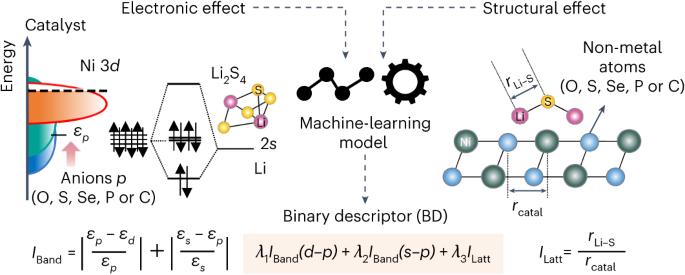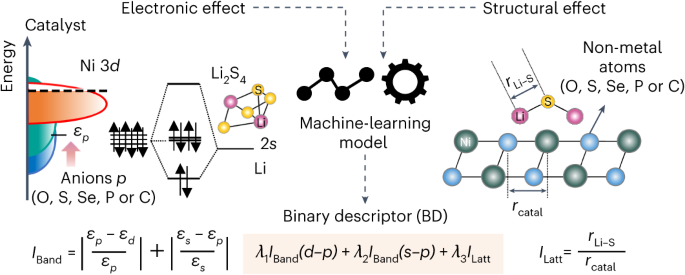Machine-learning-assisted design of a binary descriptor to decipher electronic and structural effects on sulfur reduction kinetics
IF 2
3区 工程技术
Q3 CHEMISTRY, MULTIDISCIPLINARY
引用次数: 0
Abstract
The catalytic conversion of lithium polysulfides is a promising way to inhibit the shuttling effect in Li–S batteries. However, the mechanism of such catalytic systems remains unclear, which prevents the rational design of cathode catalysts. Here we propose the machine-learning-assisted design of a binary descriptor for Li-S battery performance composed of a band match (IBand) and a lattice mismatch (ILatt) indexes, which captures the electronic and structural contributions of cathode materials. Among our Ni-based catalysts, NiSe2 exhibits a moderate IBand and the smallest ILatt and is predicted and subsequently verified to improve the sulfur reduction kinetics and cycling stability, even with a high sulfur loading of 15.0 mg cm−2 or at low temperature (−20 °C). A pouch cell with NiSe2 delivers a gravimetric specific energy of 402 Wh kg−1 under high sulfur loading and lean-electrolyte operation. Such a fundamental understanding of the catalytic activity from electronic and structural aspects offers a rational viewpoint to design Li–S battery catalysts. The sluggish conversion of lithium polysulfides in Li–S batteries can be overcome by the use of catalysts, but their design is typically done via trial and error. Now, a binary descriptor is proposed by machine learning to capture electronic and structural effects for the design of Li–S battery cathode catalysts.


机器学习辅助设计二元描述符,破解电子和结构对硫还原动力学的影响
锂多硫化物的催化转化是抑制锂-S 电池中穿梭效应的一种可行方法。然而,这种催化体系的机理仍不清楚,这阻碍了正极催化剂的合理设计。在此,我们提出了机器学习辅助设计锂-S 电池性能的二元描述指标,该指标由带匹配(IBand)和晶格错配(ILatt)指数组成,可捕捉阴极材料的电子和结构贡献。在我们的镍基催化剂中,NiSe2 的 IBand 值适中,ILatt 值最小,即使在 15.0 mg cm-2 的高硫负荷或低温(-20 °C)条件下,也能改善硫还原动力学和循环稳定性。采用 NiSe2 的袋式电池在高硫负荷和贫电解质运行条件下的重量比能量为 402 Wh kg-1。这种从电子和结构方面对催化活性的基本认识为设计锂-S 电池催化剂提供了一个合理的视角。多硫化锂在锂-S 电池中的缓慢转化可以通过使用催化剂来克服,但催化剂的设计通常是通过反复试验来完成的。现在,我们通过机器学习提出了一种二元描述符,以捕捉电子和结构效应,从而设计锂-S 电池阴极催化剂。
本文章由计算机程序翻译,如有差异,请以英文原文为准。
求助全文
约1分钟内获得全文
求助全文
来源期刊

Journal of Chemical & Engineering Data
工程技术-工程:化工
CiteScore
5.20
自引率
19.20%
发文量
324
审稿时长
2.2 months
期刊介绍:
The Journal of Chemical & Engineering Data is a monthly journal devoted to the publication of data obtained from both experiment and computation, which are viewed as complementary. It is the only American Chemical Society journal primarily concerned with articles containing data on the phase behavior and the physical, thermodynamic, and transport properties of well-defined materials, including complex mixtures of known compositions. While environmental and biological samples are of interest, their compositions must be known and reproducible. As a result, adsorption on natural product materials does not generally fit within the scope of Journal of Chemical & Engineering Data.
 求助内容:
求助内容: 应助结果提醒方式:
应助结果提醒方式:


